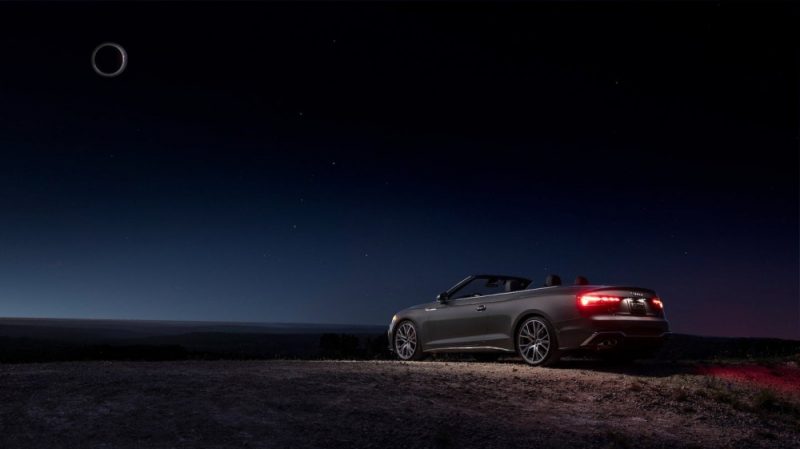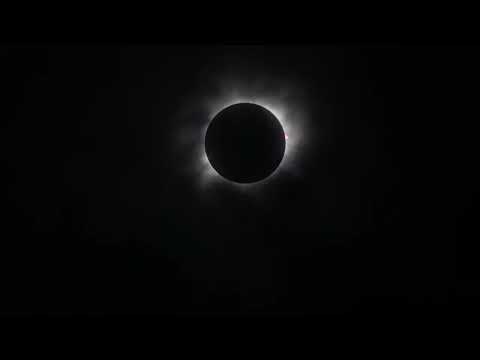The full sensory experience of eclipse totality, from inside an Audi convertible

NASA’s Science Mission Directorate Heliophysics Division studies the nature of the sun and everything it touches. That includes the Earth, the atmosphere, and the magnetosphere, which is basically the planet’s force field against solar wind and radiation. As the United States amps up to a fever pitch due to today’s total solar eclipse, NASA is ground zero for the most interesting studies and history about this natural phenomenon.
Today the sun is more of a rock star than usual, with “eclipse parties” in full swing, and roadside stands selling commemorative t-shirts and cardboard viewing glasses are popping up all along the path of totality. Dr. Kelly Korreck, a heliophysicist and NASA’s eclipse lead, gave us the background on this captivating astro-event and offered tips on the best viewing areas.
We asked Dr. Korreck if watching the eclipse from a convertible (specifically, a tech-focused Audi S5 Cabriolet) would be a good idea, and she said it would be very appropriate. After all, besides safety glasses and a clear view of the sky, the only other thing you need is a great place to sit and lean your head back.
As we waited for the clouds to clear from the sky, our photography team was a bit nervous. We got glimpses of the eclipse as the moon cast its great shadow, but would it clear? We’d soon find out.

Spoiler: It was amazing. Video: Audi
An eclipse ushers in boatloads of scientific data points
If the moon’s shadow doesn’t excite you, consider this: Albert Einstein published his theory of general relativity in 1915, but it wasn’t proven until the total solar eclipse of 1919 when Sir Arthur Eddington and his team measured the influence of the sun’s gravity on starlight.
Dr. Korreck has been fascinated by the biggest star in our universe–the sun, of course–since long before she earned her doctorate on the subject. Scientists have long used solar eclipses to make scientific discoveries, she says. Eclipses led us to the first detection of helium, for instance, and this one will continue to give scientists the opportunity to study the sun’s effect on the ionosphere. Disturbances in the ionospheric layer can cause blips in our GPS navigation systems and communications, especially radio waves.
To that end, we tested the Audi S5’s unique Bluetooth-connected seatbelt microphones, which enable clear conversations even with the top down. Three thumbtack-sized microphones are built into the outward-facing side of the seatbelt, which makes talking to someone like a brilliant NASA heliophysicist even more interesting. We also kept an eye on the S5’s GPS system, which didn’t flinch.

Eclipses happen about every 18 months somewhere in the world, but only in the same place every 400 to 1000 years, Dr. Korreck told us. In fact, the last total solar eclipse in Austin, Texas was more than 600 years ago, in 1397. Austin didn’t even exist back then. And the next one won’t be until 2343, long after we’re all gone.
“Any specific town or city normally only gets an eclipse between every 400 and 1,000 years,” Dr. Korreck says. “So it’s very rare to [see one] in a specific location, but somewhere on Earth is getting this special dance, this special alignment of the planets.”
The reason this particular total eclipse is so unusual is because it’s occurring during the period of “solar maximum,” when the sun is most active. There’s even a chance to see “streamers,” which NASA says will look like bright, pink curls or loops emanating from the sun. Heliophysicists (and the entire scientific community) are excited about this eclipse, because of the length and the intensity of the sun’s magnetic field in this period of time.
“We’re at four and a half minutes for this eclipse,” Dr. Korreck says. “It was only two and a half minutes maximum in 2017, but it’ll be six-ish minutes in 2045. So we have more to look forward to in 20 years.”
It’s more than just a visual event
When the moon stands between the sun and the Earth, the temperature outside can drop quickly – up to 10 degrees. I turned on the heated headrest, which blows warm air onto my neck; a welcome feature when you’re chilly. In Texas, it’s hot more often than it’s cold, so typically I’d use the cool setting to whisper cooling air instead. During an eclipse, the shroud of shadow blocking the sun erases heat quickly. So the sky goes dark, the temperature falls, and there’s even a measurable sound component.

“We mapped the bright light of the sun to a flute sound,” Harvard astronomer Allyson Bieryla told CNN on Friday. “Then it goes to a midrange, which is a clarinet, and then during totality, it kind of goes down to a low clicking sound, and that clicking even slows down during totality.”
That doesn’t even count the chirps, croaks, whines, and other sounds of the animal and insect kingdom as they process the odd turn of light during the event.
“I think in general, an eclipse is such a full body experience,” Dr. Korreck says. “It gets colder, the light changes, the shadow gets a bit sharper. It’s a way to really experience a celestial event more than just a visual. Take some time to really enjoy it and take advantage of the special alignment that we have.”
As the moment of totality approached, nearby horses brayed and dogs barked, as if it were truly twilight. And then it happened: The clouds parted and the sky grew dark, the animals quieted, and a stillness blanketed the landscape. We could see solar flares peeking from behind the corona, and Venus appeared below the sun. Outside of the S5 Cabriolet, the car’s headlights and taillights cast a signature pattern. For a couple of minutes, time stood still, and then daylight crept in again. It’s something I’ll never forget.










